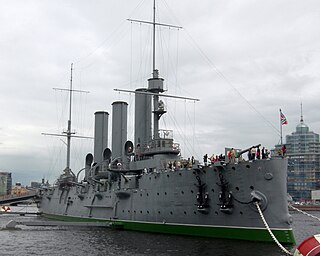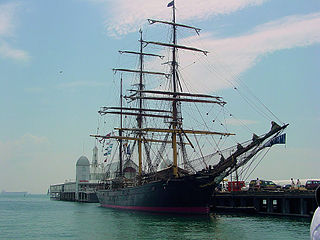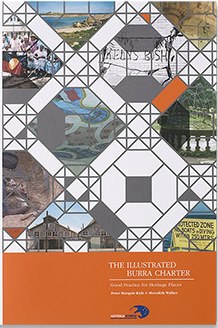Related Research Articles

Maritime transport or more generally waterborne transport, is the transport of people (passengers) or goods (cargo) via waterways. Freight transport by sea has been widely used throughout recorded history. The advent of aviation has diminished the importance of sea travel for passengers, though it is still popular for short trips and pleasure cruises. Transport by water is cheaper than transport by air or ground, but significantly slower for longer distances. Maritime transport accounts for roughly 80% of international trade, according to UNCTAD in 2020.
The International Council on Monuments and Sites is a professional association that works for the conservation and protection of cultural heritage places around the world. Now headquartered in Charenton-le-Pont, France, ICOMOS was founded in 1965 in Warsaw as a result of the Venice Charter of 1964 and offers advice to UNESCO on World Heritage Sites.

A museum ship, also called a memorial ship, is a ship that has been preserved and converted into a museum open to the public for educational or memorial purposes. Some are also used for training and recruitment purposes, mostly for the small number of museum ships that are still operational and thus capable of regular movement.

Mystic Seaport Museum or Mystic Seaport: The Museum of America and the Sea in Mystic, Connecticut is the largest maritime museum in the United States. It is notable for its collection of sailing ships and boats and for the re-creation of the crafts and fabric of an entire 19th-century seaport village. It consists of more than 60 historic buildings, most of them rare commercial structures moved to the 19-acre (0.077 km2) site and meticulously restored.

James Craig is a three-masted, 19th century iron-hulled barque restored and sailed by the Sydney Heritage Fleet, Sydney, Australia. She is one of only four pre-20th century barques in the world that still go regularly to sea.

PS Waverley is the last seagoing passenger-carrying paddle steamer in the world. Built in 1946, she sailed from Craigendoran on the Firth of Clyde to Arrochar on Loch Long until 1973. Bought by the Paddle Steamer Preservation Society (PSPS), she has been restored to her 1947 appearance and now operates passenger excursions around the British coast.

Conservation and restoration of immovable cultural property describes the process through which the material, historical, and design integrity of any immovable cultural property are prolonged through carefully planned interventions. The individual engaged in this pursuit is known as an architectural conservator-restorer. Decisions of when and how to engage in an intervention are critical to the ultimate conservation-restoration of cultural heritage. Ultimately, the decision is value based: a combination of artistic, contextual, and informational values is normally considered. In some cases, a decision to not intervene may be the most appropriate choice.

Cultural heritage is the heritage of tangible and intangible heritage assets of a group or society that is inherited from past generations. Not all heritages of past generations are "heritage"; rather, heritage is a product of selection by society.
The Venice Charter for the Conservation and Restoration of Monuments and Sites is a set of guidelines, drawn up in 1964 by a group of conservation professionals in Venice, that provides an international framework for the conservation and restoration of historic buildings. However, the document is now seen by some as outdated, representing Modernist views opposed to reconstruction. Reconstruction is now cautiously accepted by UNESCO in exceptional circumstances if it seeks to reflect a pattern of use or cultural practice that sustains cultural value, and is based on complete documentation without reliance on conjecture. The change in attitude can be marked by the reconstruction in 2015 of the Sufi mausoleums at the Timbuktu World Heritage Site in Mali after their destruction in 2012.

Edwin Fox is one of the world's oldest surviving merchant sailing ships. The Edwin Fox is also the only surviving ship that transported convicts to Australia. She is unique in that she is the "only intact hull of a wooden deep water sailing ship built to British specifications surviving in the world outside the Falkland Islands". Edwin Fox carried settlers to both Australia and New Zealand and carried troops in the Crimean War. The ship is dry-docked at The Edwin Fox Maritime Centre at Picton in New Zealand.

The International Committee for the Conservation of the Industrial Heritage, usually known by its acronym TICCIH, is the international society dedicated to the study of industrial archaeology and the protection, promotion and interpretation of the industrial heritage. TICCIH's Nizhny Tagil Charter (archived), signed in 2003, is the international guidance document for the industrial heritage. In 2011, the Joint ICOMOS – TICCIH Principles for the Conservation of Industrial Heritage Sites, Structures, Areas and Landscapes, also called "The Dublin Principles", were adopted in Paris.

Western Union is a historic schooner located in Key West, Florida, United States. She is berthed at the Key West Bight at 202 William Street. Western Union is the last surviving authentic working tall ship built in Florida. On May 16, 1984, Western Union was added to the US National Register of Historic Places. She is also the official flagship of the State of Florida and the flagship of the city of Key West.

The Burra Charter is a document published by the Australian ICOMOS which defines the basic principles and procedures to be followed in the conservation of Australian heritage places. The Charter was first endorsed in 1979 as an Australian adaptation of the Venice Charter, but with the introduction of a new analytical conservation model of heritage assessment that recognised forms of cultural heritage beyond tangible and physical forms. The Charter was the first national heritage document to replace the Venice Charter as the basis of national heritage practice. The Charter has been revised on four occasions since 1979, and has been internationally influential in providing standard guidelines for heritage conservation practice.

The Indian National Trust for Art and Cultural Heritage (INTACH) is a non-profit charitable organisation registered under the Societies Registration Act, 1860.

USAT Thomas H. Barry, formerly SS Oriente, was a Ward Line ocean liner that became a United States Army troopship in the Second World War. She was intended for transfer to the United States Navy and assigned the hull number AP-45, but was not transferred and remained with the Army.
Ingo Heidbrink is a German maritime historian who is Professor of History with a specialization on Maritime History at Old Dominion University in Norfolk, Virginia. He is specialized on Fisheries History, Traditional Watercraft and Museum Ships, Methodology of Maritime History and interdisciplinary research projects. Since Summer 2021 he is Chair of the Department of History at Old Dominion University.
The Athens Charter for the Restoration of Historic Monuments is a seven-point manifesto adopted at the First International Congress of Architects and Technicians of Historic Monuments in Athens in 1931.

The values embodied in cultural heritage are identified in order to assess significance, prioritize resources, and inform conservative-restorative decision-making. It is recognised that values may compete and change over time, and that heritage may have different meanings for different stakeholders.
The Convention for the Protection of the Architectural Heritage of Europe is a legally binding instrument which set the framework for an accurate conservation approach within Europe. For a total of forty three member states of the Council of Europe, the convention's total ratification/accession has reached forty-two countries since it was opened for signature in 1985. It entered into force on 1 December 1987.
The Institute of Historic Building Conservation (IHBC) is a professional body in the United Kingdom which was formed as a charitable trust company in 1997 by members of the former Association of Conservation Officers. The object was to widen the scope of the profession from those mainly concerned with the statutory regulation of the historic environment to all those who practice professionally in historic and built environment conservation.
References
- ↑ Ingo Heidbrink (ed.), The Barcelona Charter, European Charter for the Conservation and Restoration of Traditional Ships in Operation. Bremen (Hauschild Vlg) 2003.
- ↑ EMH Safety Council - Memorandum of Understanding (MoU)
- ↑ National Research Institute for Cultural Properties, Tokyo, Conservation of Vessels, Tokyo (Office Hans)2004